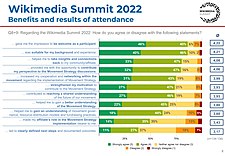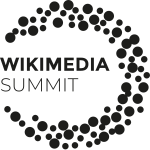Wikimedia Summit 2022/Event-report/Lessons learned
| Overview | Outcome and evaluation | Lessons learned | Financial Report |
Success
editDesigning and organizing Wikimedia’s first hybrid conference, without pre-existing guidelines and standards.
editThe Wikimedia Summit 2022 was the first hybrid conference of the Wikimedia Movement, defining hybrid by providing participants on site and online the possibility not only to watch, but to interact, participate, and contribute. The decision to organize a hybrid event was motivated by our desire to extend participation beyond logistical constraints and travel restrictions to foster inclusion within our movement. While the aspect of inclusion that hybridity offers is essential and very much core to the idea of Movement Strategy, it adds a whole new layer of complexity to the entire event and essentially all its aspects.
While some local Wikimedia events already had some hybrid component (most of the time a live stream with limited online interaction) we wanted to go further in the inclusion of online participants and had to operate without a clear framework to do so. We had to experiment and develop a new event concept without being able to rely on pre-existing standards and guidelines from the movement.
A key learning around hybridity is the need to think of and include it right from the start, as it structures and impacts everything following afterward. Already at the start of the planning process you need to define what level of hybridity is desired and actually possible. This includes questions like: What is the level of online participation and inclusion that we want to offer? How do we define participation? What kind of interactions are needed between participants? Answers to these questions are essential to define technical needs and set a general framework for participation and program design. They also help participants know what degree of inclusion to expect and manage expectations.
Onboarding an external service provider and working closely with them to design and run a successful hybrid event.
editAlmost all conferences in the Wikimedia movement are planned and organized by the movement’s organization and groups, and external parties are very rarely involved. For the Wikimedia Summit 2022, for the first time an external event agency was involved in planning and organizing the event, as its hybrid nature required capacities not available in-house.

Assuming that all future events with this level of hybridity will require to work closely with an external service provider, onboarding them carefully into Wikimedia’s culture and complexity and establishing a good working relationship is essential to the success of the event. Understanding the opportunities and limitations imposed by hybrid logistics upon the event program at an early stage is a key factor of success for any hybrid event. While logistics and program-design can usually be separated from one another in on-site events, hybrid events require a very strong level of coordination between these two areas as well as a common understanding of goals and needs. The planning of the hybrid Summit required us to think simultaneously of three dimensions when designing the event program: the on-site experience, the online experience and the connection of both.
Creating an inclusive participant experience in a hybrid context.
editDue to the absence of guidelines for organizing a hybrid Summit, we needed to thoughtfully design the overall architecture and choreography of the event. With our main goal being to enable hybrid conversations and create inclusion for both online and on-site participants, we decided to design a one-track program with multiple breakout rooms. This ensured that all participants were part of the same conversations and focussed on one topic at a time. For each session, we created up to 10 breakout rooms, each of them being fully equipped for both on-site and online participation. While the high amount of breakout rooms created logistical challenges (multiplied needs for equipment and facilitators) it also enabled hybrid conversations and participation by dividing participants into small groups.

However, due to the short planning time, we couldn’t prepare and support breakout rooms facilitators in the most optimal way. For future events, we would consider organizing a training for facilitators prior to the event and sharing facilitation guides with all necessary information at least one week before the event.
Putting safety first
editCOVID-19 prevention measures
edit
WMDE and WMF partnering to ensure a friendly conference space, on-site and online
editAll Summit participants had to agree to adhere to the Universal Code of Conduct to participate in the Summit. Trust and safety agents from WMDE and WMF were present during the event to ensure the UCoC is being adhered to and to assist participants if needed. Due to the hybrid settings, trust and safety agents had to be deployed on-site as well as on the event platform. We made sure that the trust and safety team would have access to key admin functions on the online platform to be able to intervene if needed. In the on-site location, trust and safety agents were being identified by a ‘safety’ pink vest and an awareness room was available at all times for people in need of assistance. There was no report of any case that would have required the exclusion of a participant.
Challenges
editThe planning period of the Summit should not be shorter than 12 months
editDue to the unforeseeable evolution of the pandemic, we only made the final decision to host the Summit at the end of March 2022. As we expected an increase of the COVID-19 infections in winter 2022, we decided to host the Summit in early September, which led to a very short planning period of 6 months. This put additional constraints on the inherent challenges of planning the first ever hybrid Summit.
Eventually, we realized that due to holidays in Europe and the US and the proximity of other Wikimedia events (Wikimania, regional events) September isn’t the ideal month to host the Summit. Due to diverse events happening in September in Berlin, most venues and hotels were already booked and finding an event location that met our needs was very challenging. Based on these learnings, we suggest that the next Summit should return to the first half of the year and happen in March / April 2024.
Despite our efforts, structural barriers kept us from ensuring full equity and inclusion for all parts of our movement.
editSelection of participants
editThe venue capacity and hygiene considerations led us, among other factors, to limit the number of participants and to introduce an application process for participants based on movement strategy engagement. Since we were aware that such an application process may benefit the most represented and privileged parts of our movement, we tried to balance this dynamic by allocating special points for ‘movement newcomers’ who had been previously kept away from participating in global conversations due to structural injustice. While attention was given to the geographical representation of affiliates in the selection process, the final participant list didn’t fully represent the diversity of our movement. Having to select participants poses several challenges: How to ensure diversity of participants? How to define fair selection criteria? Who should make these decisions? In future events, we will keep trying to find new answers to these questions in consultation with the Summit audience and work towards more equity.
Visa and travel restrictions
editParticipants had to face the injustices and frustrations caused by international visa and travel restrictions. A total of 15 affiliate representatives could not attend the Wikimedia Summit in Berlin due to the rejection of their visa application or the absence of an available visa appointment in the due time for the Summit and due to the introduction of a new, digitized booking system for visa appointments. Whilst some of the underlying reasons for visa rejections lie beyond our power, announcing the final participant list at least 3 months before the event could increase the chance of success for visa applicants. Additionally, the event organizers have supported visa application by providing additional supporting documents and contacting the Federal Foreign Office and respective embassies whenever possible. Wikimedia Deutschland will continue to examine possible ways to support future visa processes.
Lack of multilingualism
editEnglish was the only working language at the Summit. Although offering interpretation has become a standard in online conversations around movement strategy, this was not possible at the Summit this year due to the overall architecture of the hybrid event. Indeed, the existence of 10 online and on-site breakout rooms per session rendered virtually impossible to offer interpretation services for all – both in terms of financial and logistical challenges. To make it nevertheless a bit easier for non English native speaking participants, participants speaking the same language were connected, and possibilities to take notes or speak using the preferred language were created. Wikimedia Deutschland recognizes the value of multilingualism and the commitment of movement strategy towards the diversity of our movement. Since multilingualism would have major implications on hybridity, any future hybrid Summit will benefit from a better understanding of participant expectations and logistical limitations around interpretation services.
There could have been more collaborations and interactions between online and on-site participants.
editOur ambition with this hybrid Summit was to design an equally inclusive experience for both online and on-site participants. This meant for us to not only run two parallel events but to really enable conversations between online and on-site participants and create spaces for collaboration and informal networking. Building bridges between the online and on-site spaces and creating interactions between participants has been the most challenging part of the hybrid design.
While formal interactions could happen in the breakout sessions, most of the informal exchange didn’t happen between online and on-site participants. Based on the evaluation survey, on-site participants benefited more from informal networking and connections than online participants. While online ‘social spaces’ were available at all time for on-site and online participants to connect informally during the event, these were rarely used and when so, mostly by online participants only.
In the future, we should try and find new ways to encourage informal interactions between participants and strengthen the sense of human connection in hybrid settings. One possibility could be to set up several stations with notebooks at the event venue to encourage participants to spontaneously join online rooms and exchange with online participants.
We didn’t create the best conditions to have the in-depth conversations that our movement needs.
editDue to the very short planning period and the high resources put into logistics, we couldn’t organize participant engagement prior to the event. Although we shared onboarding materials, they may not have been fully adapted to the different needs and level of previous engagement of all participants. Additionally, we didn’t have the capacity to allocate in each breakout room a resource person to answer questions and share their expertise. These factors set limitations to our ambitions with the Summit program.

Indeed, sessions on day 2 of the Summit were focused on the governance reform and the way our movement is funded. Due to the complexity of these topics and their various implications on the affiliates, the conversations would have benefited from a previous engagement and an extensive onboarding of all participants. Indeed, the absence of common understanding and lack of a common language around these topics limited the session's outcomes. Consequently, we couldn’t fully meet our ambition to enable in-depth conversations around hubs, governance and fundings that would generate answers to guide the work of the Movement Charter Drafting Committee. In the evaluation survey, participants primarily valued the Summit for ‘understanding movement strategy’ rather than ‘moving movement strategy further’. This was also highlighted by the lack of call for action after the Summit and clarity in the next steps by the participants.
